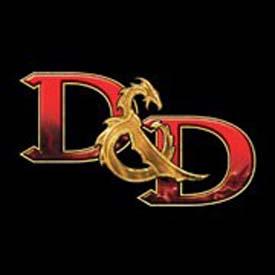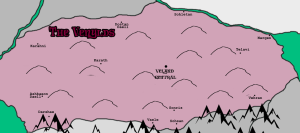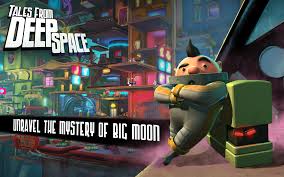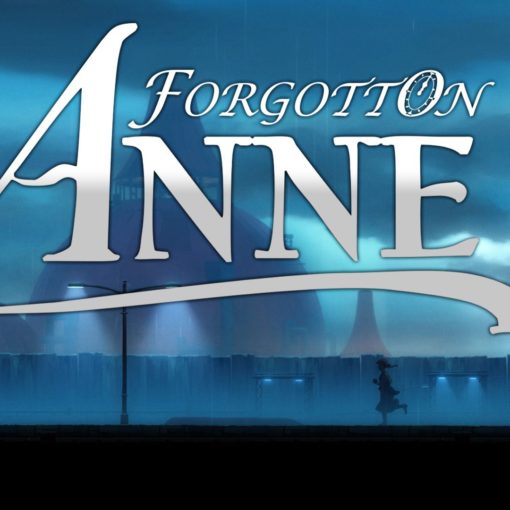I sit at my dining room table, surrounded by hand-drawn maps and coloured pencils. My laptop is open to Discord, where my friends pester me with questions. They send me detailed descriptions of character history, ask about dragons and gods, allies and enemies. I have books open to carefully calculated statistics involving zombies, ghouls, and bandits. A small bag of dice sits open next to a cup of abandoned coffee, and symphonic metal music plays in the background. It is almost midnight, and I expect to be up another few hours at the minimum.
I’m having so much fun, and we haven’t even started to play yet.
It’s been over five years since I ran a long form Dungeons and Dragons campaign. I’ve written about my history as a D&D player before in passing, but as I start putting together a new game, I find myself reflecting on my past experiences as a Dungeon Master (or DM) and what it means to run a game like this.
My first experience as a DM was my sophomore year of college, when my friends and I had a tabletop themed birthday party celebration. I ran a short game for six friends who had never played before, a kind of introduction session to the mechanics of playing. The summer following that I ran a game for eight players that lasted for several months, and all through my undergraduate life I was in at least two games while running another. I’m not exaggerating when I say that D&D fundamentally shaped my experiences as a person, a writer, and a gamer, and even though my schedule as a graduate student is jam-packed with responsibility, I’ve been fortunate enough to find time to occasionally play short games with my friends in Alabama.
This game is different though. My past experiences have been primarily focused around an in-person social interaction, with everyone seated at a table with dice and paper character sheets, maps and miniatures scattered about and occasionally attacked by cats. The game I’m preparing now is entirely virtual by necessity – the closest of my players is in Chicago. Another is in Kentucky, a third in Rhode Island, and my remaining two players aren’t even in the United States, living in England and Portugal respectively. This game will mark my first experience as a completely digital DM, running and managing a game in virtual reality.
Digital run D&D has become increasingly common, with tools available online for players worldwide to come together and collaborate on stories and games of high adventure. The availability of materials online combined with the usability of new voice chat programs like Discord has propelled tabletop gaming into the twenty-first century, making it possible for me to be in my living room in Indiana while my friends are hundreds, even thousands of miles away. My players are diverse, friends of mine from fandom circles with levels of experience with D&D ranging from old hat to brand new. Over the last few days the six of us have been going on a kind of crash course into the first step of my game: worldbuilding.
My roots lie heavily in appreciation for works of fantasy. I’ve been a fan of JRR Tolkien since childhood, devoured countless fantasy epics, become immersed in worlds of high adventure and battles against the forces of evil. In college, playing D&D fed that part of my soul while also giving me an outlet for my urge to tell stories. D&D is a game that seems to be part random happenstance, part confusing mathematics, and part collaboratively stumbling blind into various narratives, and these are the things that led to me taking a map I had drawn of a fictional world two years ago and turned it into the setting for my D&D campaign.
Aeridas is a standard fantasy world, full of dragons and elves and gods, battles against good and evil, and magic. I approached my players with a simple campaign concept, and gave them the basics: the year is 9999 in the Age of the Elements, Dragons rule the world, you’re living in the wild lands trying to make a living, and when you meet you will be thrown into circumstances that will impact the very fabric of existence. I kept things this vague for a reason, and that reason lies in my approach as a DM. Some campaigns are pre-set from the beginning, and you can buy pre-made adventures that lead players through a designed scenario. It’s an easier approach, requires less planning by the DM, and still results in hours of fun. I’ve always been pretty bad at making things easy on myself. I could run a pre-made game, and still have a good time. But for me, it defeats the purpose of playing the game, because my purpose in playing D&D is that act of collaboration.
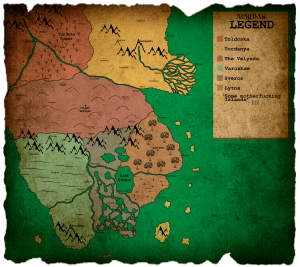
I have five players, and over the last few days i’ve asked them for backstory information. I want to know the basics, like their name, race, and player class, but the other questions I ask them are generative for me. I ask them for the name of a non-player character (or NPC) who they know at the start of the game, someone they are still in touch with. I ask them for a second NPC, someone they share with me but not the rest of the group. I ask them for allies and enemies, for the gods they worship, and for interesting quirks. As I ask them questions, more ideas come to the surface, stories begin to unfold that can be weaved seamlessly into my overarching plan for the game (which I’m not going to reveal here — I suspect my players will read this post, and I don’t want to spoil anything).
An example: my boyfriend is playing an elf rogue named Haaith Freanithym, a traveling adventurer in search of cursed objects and new experiences. She’s a young woman with many secrets, who is in the starting location to find more objects to peddle for fun and profit. Her NPC contact is a dragon named Karrigan Wayke, a character I created specifically to be the person Haaith sells cursed objects to. Another of my PCs, playing an undead human cleric named Jake Reiners, is in close contact with the dragon cleric that raised him from the dead after a bar fight four years previously. Thus, I have two NPCs, relevant to the histories and backstories of my players, now existing and making the world somewhat more rich and complex for them and for me.
We talk a lot about collaboration here at NYMG, and I think that’s one of the reasons I’m writing about this D&D game, because it’s giving me a chance to reflect on collaboration from both a gaming and writing perspective. Because we live in such disparate locations, most of the game planning thus far has taken place in writing, and I now have multiple hours worth of conversations, google docs, and collaborative works from each of my players. The game has yet to begin and we’re already building a world together. My players give me ideas and I turn them into something they can experience, using my imagination and the mechanics available to me in 5th Edition D&D.
I intend to write more about this game in the future, because it’s a new experience for me, a recontextualizing of a previous gaming experience, a chance to take something inherently analog and play with it in a digital realm. It’s also an opportunity to tell a story with the help and encouragement of a group of creative and talented friends who want something immersive and entertaining to explore.
My campaign is called Shards Falling on Aeridas, and I’ll be building that world as the DM with the help of five characters: Haaith, Jake, Naphi, Almas, and Primeria. This chance to collaborate, to play, and to explore one of my favorite hobbies in a new context is exactly what I need to take a break from the crush of graduate school. I’m looking forward to bringing my friends along on this journey.

